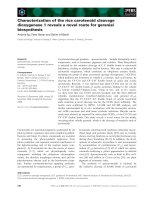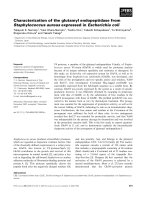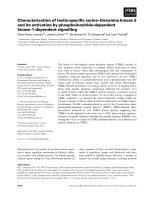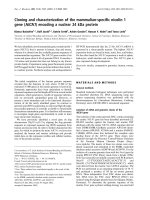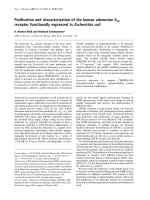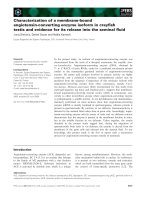Investigation and characterization of splice variations of l type ca2+ channel, cav 1 3, in chick basilar papilla and rat cochlea hair cells iimplications in hearing
Bạn đang xem bản rút gọn của tài liệu. Xem và tải ngay bản đầy đủ của tài liệu tại đây (4.69 MB, 132 trang )
i
INVESTIGATION AND CHARACTERIZATION OF
SPLICE VARIATIONS OF L-TYPE Ca
2+
CHANNEL,
Ca
V
1.3, IN CHICK BASILAR PAPILLA AND RAT
COCHLEAR HAIR CELLS: IMPLICATIONS IN
HEARING
SHEN YIRU
MASTER OF SCIENCE, NUS
A THESIS SUBMITTED FOR THE DEGREE OF
DOCTOR OF PHILOSOPHY
DEPARTMENT OF PHYSIOLOGY
NATIONAL UNIVERSITY OF SINGAPORE
2006
ii
ACKNOWLEDGMENTS
First and foremost, I would like to extend my deepest appreciation and
gratitude to my supervisor, Associate Professor Soong Tuck Wah, who was always
available to oversee my project and give his expert advice. I thank him for his
constant guidance and encouragement throughout my PhD training in the lab.
Thanks also go out to Dejie, Mui Cheng, Tan Fong, Gregory Tan, Ying Ying,
Liao Ping and everyone else in the laboratory for their valuable assistance and
teaching. I am also grateful to our collaborators: Professor David T Yue
(electrophysiology of calcium channels), Professor Paul A Fuchs and Dr Hakim Hiel
for their expert advice and technical assistance in understanding the physiology of
cochlear.
My sincere thanks also go to my thesis examiners for spending their time on
this thesis. Lastly, I would like to express my utmost appreciation to my family, for
their love and encouragement.
iii
TABLE OF CONTENTS
Title page i
Acknowledgements ii
Table of Contents iii
List of publication vi
Summary vii
List of Tables x
List of Figures xi
Abbreviations xiii
Chapter 1 1
Introduction 1
1.1 Voltage-gated calcium channels 3
1.1.1 L-type voltage-gated calcium channel (LTCCs) 4
1.1.2 L-type voltage-gated calcium channel subunits structure 5
1.2 Ca
v
1.3 voltage-gated calcium channels 6
1.2.1 Alternative splicing of Ca
v
1.3 gene 10
1.2.2 Ca
v
1.3 and cochlea 14
1.2.3 Ca
v
1.3 and other tissues 14
1.3 Mechanism of calcium dependent inactivation (CDI) 16
1.4 The organ of Corti 17
1.5 Anatomy and functional diversity of the cochlea 20
1.6 Objectives of the study 24
Chapter 2 26
Materials and Methods 26
2.1 Tissues preparation and distribution of splice variant, Ca
V
1.3
IQΔ
27
iv
2.2 Generation of polyclonal antibodies 28
2.3 Protein immunoblotting 29
2.4 Electrophysiological recordings and data analysis 30
2.5 Immunocytochemistry 32
2.5.1 Whole-mount tissues 32
2.5.2 Frozen-sections 33
Chapter 3 35
Results 35
Part I Alternative splicing at the C-terminus of rat cochlear Ca
v
1.3a
1
subunit 36
3.1 Transcript-scanning of Ca
v
1.3a
1
subunit of rat cochlear hair cells 36
3.2 Relative abundance of Ca
v
1.3
IQD
splice variants in developing rat cochlea 42
3.3 Construction of full-length Ca
v
1.3
IQD
channels 44
3.4 Ca
v
1.3
IQD
channels lack Ca
2+
-dependent inactivation 47
3.5 Elimination of CDI in Ca
V
1.3
IQ∆
channels is independent of β-subunit
isoform 52
3.6 Construction of Ca
V
1.3
IQΔ
-GST for protein induction 56
3.7 Characterization of pAb_DIQ and pAb_Ca
v
1.3 specific antibodies 59
3.8 Selective localization of Ca
V
1.3
IQD
and Ca
V
1.3
IQfull
channels within
cochlear hair cells 62
3.9 Alternative splicing at the I/II loop region of rat cochlear hair cells 66
Part II Alternative splicing of Ca
v
1.3a
1
subunit in chick basilar papilla 70
3.10 Detection of Ca
v
1.3
IQD
splice variant in whole chick basilar papilla 70
3.11 Detection of Ca
v
1.3
IQD
splice variant in single cell RT-PCR of chick
hair cells 72
3.12 Relative abundance of Ca
v
1.3
IQD
splice variant in developing chick
cochlea 74
3.13 Electrophysiological recording of chick cochlear hair cells (THCs) 76
v
3.14 Selective localization of Ca
v
1.3
IQD
channels in chick cochlea 78
Part III Alternative splicing of Ca
v
1.3a
1
subunit in other tissues 80
3.15 Tissue distribution of splice variant Ca
v
1.3
IQD
80
Chapter 4 84
Discussion and Conclusion 84
4.1 Identification and characterization of splice variant Ca
v
1.3
IQD
in
rat cochlea 85
4.2 Roles of Ca
v
1.3
IQD
channels in native hair cells 88
4.3 Roles of Ca
v
1.3
IQD
channels in other tissues 92
4.4 Importance of diminished inactivation of Ca
V
1.3 channels within
hair cells 93
4.5 Potential mechanisms for switching the inactivation of Ca
V
1.3 channels
in hair cells 94
4.6 Tools for in vivo dissection of Ca
V
1.3 function in hair cells 98
4.7 Future plans 98
References 100
vi
LIST OF PUBLICATION
1. Yiru Shen, Dejie Yu, Hakim Hiel, Ping Liao, David T. Yue,
Paul A. Fuchs and
Tuck Wah Soong. Alternative splicing of the Ca
V
1.3 channel IQ domain¾a
molecular switch for Ca
2+
- dependent inactivation within auditory hair cells (Journal
of Neuroscience, 26(42): 10690-10699)
ABSTRACTS
1. Shen Yiru and Soong Tuck Wah. Investigation and characterization of splice
variants of L-type Ca channel gene, Ca
v
1.3 in rat cochlear before, during and after
onset of hearing (NUS-NUH scientific conference, 2004)
2. Yiru Shen, Dejie Yu, Hakim Hiel, Ping Liao, David T. Yue,
Paul A. Fuchs and
Tuck Wah Soong. Alternative splicing of the Ca
V
1.3 channel IQ domain¾a
molecular switch for Ca
2+
- dependent inactivation within auditory hair cells (Society
of Neuroscience, Atlanta, Georgia 2006)
ORAL PRESENTATIONS
1. Shen Yiru “Calcium channels in hair cells” - 3
rd
Singapore International
Neuroscience Conference From Brain Research to Brain Repair 23-24 May 2006.
2. Yiru Shen “Splice variations of L-type Ca
2+
-channel, Ca
v
1.3, in rat cochlear
hair cells” Department of Neuroscience, Johns Hopkins University School of
Medicine 18 Oct 2005.
vii
SUMMARY
L-type Ca
v
1.3 voltage-gated calcium channels play important roles in insulin
secretion, regulating pacemaking activities, mediating synaptic neurotransmission in
hair cells and learning and memory. For some time, a puzzling question asked was
about the lack of correlation between the behaviors of the Ca
v
1.3 channels recorded in
native hair cells and cloned Ca
v
1.3 channels recorded in heterologous HEK293 cells.
The native Ca
2+
currents flowing through Ca
v
1.3 channels of cochlear hair cells
inactivate only little (Zidanic and Fuchs 1995) while those through heterologously
expressed Ca
v
1.3 channels in HEK 293 cells do so markedly (Xu and Lipscombe
2001).
To understand how these Ca
v
1.3 channels are adapted to such unique
behavior, as an initial step, we transcript-scanned mRNA obtained from P9 (before
onset of hearing) and P28 (after onset of hearing) rat cochlea to determine whether
alternative splicing at the C-terminus of Ca
v
1.3 gene may produce a hair cell splice
variant that does not inactivate. We found that the alternate use of exon 41 acceptor
sites generated a splice variant that lost the calmodulin-binding IQ motif in the C-
terminus. These Ca
v
1.3
IQD
(‘IQ deleted’) channels exhibited a lack of calcium-
dependent inactivation (CDI) independent of co-expressed b-subunits in HEK293
cells using whole-cell patch recordings. Steady-state inactivation (SSI) properties,
mainly reflective of voltage-dependent inactivation, were identical for both types of
channels (Ca
v
1.3
IQD
and Ca
v
1.3
IQfull
). Hence, Ca
V
1.3
IQD
channels not only expressed,
but demonstrated selective loss of CDI. We confirmed the presence of the identified
splice variant, Ca
v
1.3
IQD
by RT-PCR, Western blot analysis and
immunohistochemistry. Splice variant specific polyclonal antibodies were raised to
determine its distribution profile in the rat cochlear hair cells. Ca
v
1.3
IQD
channel
viii
immunoreactivity was preferentially localized to the cochlear outer hair cells (OHCs)
while that of Ca
v
1.3
IQfull
(IQ-possessing) channels labeled the inner hair cells. The
preferential expression of Ca
v
1.3
IQD
channels by OHCs suggests that these may play a
role in processes other than neurotransmitter release such as electromotility or gene
expression.
Besides analyzing the splicing patterns at the C-terminus of the Ca
v
1.3 gene,
we have identified all alternative splicing combinations in the I-II loop region. The I-
II loop region in Ca
v
1.3a1 subunit is known to be the location where many patterns of
splice variations can be found. Detailed analyses of the distribution of intracellular I-
II loop region splice variants revealed tissue specific and developmental regulation.
Exon 9* was found to be in developmental rat cochlea, heart and brain. Interestingly,
we find the highest expression of Exon 9* splice variant in the post-natal day 9 rat
cochlea (before onset of hearing). It will be of great interest to characterize the
physiological role of Ca
v
1.3 channels containing Exon 9* splice variant and determine
if any interacting proteins may be isolated or characterized.
Therefore, this study provides preliminary data to motivate us to look at the
expression of the splice variant Ca
v
1.3
IQD
channels in other tissues. In our recent
study, we have found the mossy fiber axons are labelled by the pAb_ΔIQ antibody
(raised against the Ca
v
1.3
IQΔ
splice variant), while the antibodies raised against other
regions of the C-terminus (short or long forms) did not label intensely. Furthermore,
the expression of splice variant Ca
v
1.3
IQΔ
channels have been found in the sinoatrial
node (SAN), which suggests that these channels may play important function in
cardiac pacemaking. It will be of great interest to transcript-scan the entire Ca
v
1.3
gene in the cochlea developmentally for new alternatively spliced exons and more
importantly, the construction of full-length Ca
v
1.3 cDNA libraries will enable us to
ix
determine the actual combinations of the various alternatively spliced exons. This
study provides essential information of new alternatively spliced exons of Ca
v
1.3
channels which may play diverse roles in the field of hearing sciences.
.
x
LIST OF TABLES
Table 1: Classification of α
1
subunits and effects of co-expression with
β subunits 9
xi
LIST OF FIGURES
Figure 1.1 Subunit composition and transmembrane topology of voltage-
dependent Ca
2+
channels 8
Figure 1.2 Patterns of alternative splicing 11
Figure 1.3 The structure of the human ear 18
Figure 1.4 Diagrammatic representation of an inner hair cell 21
Figure 1.5 Diagrammatic cross-section of the organ of Corti 22
Figure 1.6 Innervation of the organ of Corti 24
Figure 3.1 Summary of Ca
v
1.3 subunit splice variants identified at the
C-terminus of post-natal day 9 (P9) in rat cochlear hair cells 37
Figure 3.2 An example illustrating colony screening isolated from individual
bacterial colonies from P9 rat cochlear hair cells 38
Figure 3.3 Postulated splicing mechanism underlying C-terminus of
Ca
v
1.3 subunit in rat cochlear hair cells 40
Figure 3.4 Alignment of nucleotide sequences of the rat sequences (D38101)
and identified splice variant at IQ motif 41
Figure 3.5 Relative abundance of different splice variants at the region of
E41-43 of Ca
v
1.3 43
Figure 3.6 Schematic diagram of construction of full-length
Ca
v
1.3
IQ∆
channel 45
Figure 3.7 Detailed procedure of construction of splice variant ∆IQ at the
C-terminus of Cav1.3α1 subunit into parental full-length Ca
v
1.3 46
Figure 3.8 Voltage-dependent electrophysiological properties of
splice variants 49
Figure 3.9 Robust CDI exhibited by Ca
v
1.3
IQfull
channels and
weak CDI was observed for Ca
v
1.3
IQ∆
channels 50
Figure 3.10 Steady-state inactivation (SSI) properties of Ca
v
1.3
IQfull
and Ca
v
1.3
IQ∆
channels
51
Figure 3.11 Co-expression of Ca
v
1.3
IQfull
with different β-subunits shows robust
CDI but co-expression with Ca
v
1.3
IQ∆
channels lacks CDI 53
Figure 3.12 Co-expression of Ca
v
1.3
IQfull
with different β-subunits shows robust
CDI but co-expression with Ca
v
1.3
IQ∆
channels lacks CDI 54
xii
Figure 3.13 Alternative splicing at the IQ motif affect voltage-dependent
inactivation (VDI) in Ca
v
1.3
IQ∆
channels 55
Figure 3.14 Construction of pGEX-4T1 fusion protein for expression 57
Figure 3.15 Detailed procedure of constructing pGEX-4T1 fusion protein for
expression 58
Figure 3.16 Characterization of pAb_∆IQ and pAb_Ca
v
1.3 specific
antibodies by immunolabeling and western blot 61
Figure 3.17 Localization of Ca
v
1.3
IQ∆
and Cav1.3
IQfull
channels in
rat cochlear hair cells
64
Figure 3.18 Summary of Cav1.3 subunit splice variants identified
at I/II loop of various tissues 67
Figure 3.19 Splicing profile at I-II loop of different tissues 68
Figure 3.20 Relative abundance of I-II loop splice variants in
different stages of the rat cochlea and various tissues 69
Figure 3.21 Summary of Ca
v
1.3
IQ∆
splice variants identified at
C-terminus of chick basilar papilla 71
Figure 3.22 Summary of Ca
v
1.3
IQ∆
splice variants in individual hair cells of
chick basilar papilla 73
Figure 3.23 Relative abundance of I-II loop splice variants in
developmental stages of the chick basilar papilla 75
Figure 3.24 Electrophysiological recording of a single tall hair cell of chick
cochlea 77
Figure 3.25 Localization of chick pAb_IQ in chick basilar papilla 79
Figure 3.26 Summary of Ca
v
1.3
IQ∆
splice variants identified
in various tissues 82
Figure 3.27 Distribution of Ca
v
1.3
IQ∆
splice variants observed in different
regions of the brain 83
Figure 4.1 Proposed mechanism of calcium-dependent inactivation in
auditory hair cells 97
xiii
ABBREVIATIONS
AM Atrial myocytes
CDI Calcium dependent inactivation
DHPs Dihydropyridine
HEK Human Embryonic Kidney cells
IHCs Inner hair cells
O.C.T Optimum cryosectioning temperature
OHCs Outer hair cells
LTCCs L-type calcium channels
VGCCs Voltage-gated calcium channels
SGNs Spiral ganglion neurons
I-V Current-voltage relationship
SAN Sinoatrial node
LTP Long-term potentiation
LTD Long-term depression
PVDF Polyvinylidene difluoride membrane
E
rev
Reversal potential
MΩ mega ohm
nt nucleotide(s)
μl microlitre
PCR Polymerase Chain Reaction
RT-PCR Reverse Transcriptase Polymerase Chain Reaction
TEAMS Tetraethylammonium methanesulfonate
V
1/2
Voltage at 50% of channels’ activation
V
1/2 inact
Voltage at 50% of channels’ inactivation
Introduction
1
Chapter 1
Introduction
Introduction
2
INTRODUCTION
Calcium influx through voltage-gated channels plays various essential roles in
vertebrate hair cell function. The rapid rise in cytoplasmic Ca
2+
triggers transmitter
release (Zidanic and Fuchs, 1995; Glowatzki and Fuchs, 2002; Fuchs et al., 2003),
activates calcium-dependent potassium channels (Lewis and Hudspeth, 1983; Art and
Fettiplace, 1987; Fuchs and Evans, 1988), and may contribute to voltage-driven hair cell
motility that amplifies the cochlear vibration pattern (Brownell WE, 1985). Not all these
functions occur equally in every hair cell and so calcium channel proteomic structures
might vary depending on cell type. For example, voltage-gated calcium channels
(VGCCs) must be located specifically close to ribbon synapses of inner hair cells that
provide the majority of afferent signaling in the mammalian cochlea. In contrast, outer
hair cells have few if any ribbon synapses, but nonetheless may rely on VGCCs for other
functions, e.g., to support voltage-driven electromotility that is necessary for cochlear
sensitivity and frequency selectivity.
What types of VGCCs are found in hair cells? Voltage-gated calcium currents in
cochlear hair cells are sensitive to dihydropyridines (DHP) but not other channel blockers
(Art and Fettiplace, 1987; Fuchs and Evans, 1988; Hudspeth and Lewis, 1988; Zidanic
and Fuchs, 1995). A DHP -sensitive Ca
2+
channel gene, Ca
v
1.3 has been cloned from
vertebrate cochlea (Kollmar et al., 1997a; Kollmar et al., 1997b) and a Ca
v
1.3 knockout
mouse is not only deaf, but suffers loss of both inner and outer hair cells over time
(Platzer et al., 2000). Greater than 90% of the voltage-gated calcium current flows
through this channel type in cochlear hair cells, although other gene products must
contribute in vestibular hair cells (Dou et al., 2004).
Introduction
3
Interestingly, the predominant Ca
2+
current in cochlear hair cells differs
functionally from the cloned Ca
v
1.3 channel heterologously expressed in HEK cells
(Mikami et al., 1989; Koschak et al., 2001; Safa et al., 2001; Xu and Lipscombe, 2001).
Whereas native hair cell calcium currents inactivate little or not at all, the I
Ca
flowing
through heterologously expressed Ca
v
1.3 channels (independent of β subunit partnering)
showed marked calcium-dependent inactivation (CDI).
1.1 Voltage-gated calcium channels
Voltage-gated calcium channels (VGCCs) first described in excitable cells
(Hofmann et al., 1994) are generally classified according to their electrophysiological,
pharmacological and inactivation properties as either transient (T-type, Ca
v
3), long-
lasting (L-type, Ca
v
1), neuronal (N-type, Ca
v
2), purkinje cell type (P-type, Ca
v
2),
granular cell type (Q-type, Ca
v
2) and toxin/drug-resistant or residual type (R-type, Ca
v
2)
(Ertel et al., 2000; Lipscombe et al., 2002). They play important roles in calcium-
regulated neuronal functions which include neurotransmitter release (Miller, 1987),
membrane excitability and excitation-transcription coupling (Dunlap et al., 1995;
Finkbeiner and Greenberg, 1998; Komuro and Rakic, 1998; Maier and Bers, 2002). The
molecular pharmacology of these families of calcium channels is quite distinct.
Dihydropyridines (DHP) and other organic calcium channel blockers (phenylalkylamines
and related benzothiazepines) inhibit Ca
v
1 calcium channels (Glossmann and Striessnig,
1990) while Ca
v
2 calcium channels are relatively insensitive to dihydropyridines
blockers. However, these Ca
v
2 calcium channels are specifically blocked by peptide
toxins from spider and marine snails (Miljanich and Ramachandran, 1995). DHP can be
Introduction
4
channel activators or inhibitors and are thought to shift the channel toward the open or
closed state, rather than occluding the pore. Their binding sites include the amino acid
residues in the domain III S5, III S6 and IV S6 regions (Schuster et al., 1996). The Ca
v
3
subfamily of calcium channels is insensitive to both the dihydropyridines that block Ca
v
1
and peptide toxins that block Ca
v
2 channels. So far, there is no known pharmacological
agents that can block T-type calcium currents selectively (Perez-Reyes, 2003) and
development of such selective blockers of the Ca
v
3 calcium channels would be useful for
therapy.
1.1.1 L-type voltage-gated calcium channel (LTCCs)
Four Ca
v
1 genes are present in the pufferfish (Wong et al., 2006), rodents and
human and they are classified as Ca
v
1.1-Ca
v
1.4 (Hofmann et al., 1999). L-type calcium
channels are expressed in neuronal, endocrine, cardiac, smooth, and skeletal muscle, as
well as in fibroblasts and kidney cells. The importance of such VGCCs is corroborated by
the accumulating evidence that they regulate a plethora of processes including secretion
of neurohormones, neurotransmitter release (Smith et al., 1986; Augustine et al., 1987;
Augustine et al., 1989), gene expression, mRNA stability and influence the activity of
other ion channels. Ca
v
1.1, previously known as a
1S
, has only been cloned from skeletal
muscle and interacted directly with the ryanodine receptors in the sarcoplasmic reticulum
(Flucher and Franzini-Armstrong, 1996). The Ca
v
1.2, formerly known as a
1C
, is
expressed in heart (Bohn et al., 2000; Xu et al., 2003), smooth muscle (Moosmang et al.,
2003), pancreatic cells (Schulla et al., 2003) and brain (Hell et al., 1993). Ca
v
1.2 has been
considered the major L-type calcium channels in the heart. The Ca
v
1.3 gene, known as
a
1D
, is mainly found in brain, pancreas, kidney, ovary and cochlea. Previous reports have
Introduction
5
detected Ca
v
1.3 transcripts in cardiac tissues (Wyatt et al., 1997) and sinoatrial node
(Bohn et al., 2000). Ca
v
1.4, formerly known as a
1F
, is expressed primarily in retina, and
these channels are especially found at the synaptic terminals of retinal bipolar cells
(Berntson et al., 2003).
1.1.2 L-type voltage-gated calcium channel subunits structure
L-type calcium channels (LTCCs) are multi-subunit complexes formed by
different isoforms of the pore-forming α1 subunit named as α
1S
(Ca
v
1.1), α
1C
(Ca
v
1.2), α
1D
(Ca
v
1.3) and α
1F
(Ca
v
1.4). These calcium channels are ubiquitous, particularly in skeletal
and cardiac muscle, where they play an essential role in excitation-contraction coupling.
The α
1
subunit of molecular size between ~180 to ~250 kDa is the largest subunit, which
is organized in four homologous domains (I-IV), each of which contains six
transmembrane segments (S1 to S6) linked by variable cytoplasmic loops and
cytoplasmic domains of amino (N) and carboxy (C) termini (Figure 1.1). The α
1
subunit
forms the ion-conducting pore and determines the main characteristics of the channel
complex such as its ion selectivity, voltage sensitivity, pharmacology and binding
characteristics for ligands. The S4 segment serves as the voltage sensor which is thought
to move outward upon depolarization thus causing the channels to open. The re-entrant
pore loop (P loop) located in between the S5 and S6 segments form the pore lining which
determines ion conductance and selectivity.
In order to form a functional calcium channel complex, the α
1
subunit associates
with at least three auxiliary subunits (a
2
d, b and/or g) (Striessnig, 1999). Molecular
cloning has identified ten α
1
subunit genes, four different genes encoding b subunits (b
1
-
4
) (De Waard et al., 1994) (Table 1), three genes encoding a
2
d complex (Klugbauer et al.,
Introduction
6
1999; Gao et al., 2000a) and five genes encoding neuronal g subunits (Letts et al., 1998;
Klugbauer et al., 2000; Lacinova, 2005). Based on previous findings, the auxiliary
subunits increase the current amplitude (Brice et al., 1997), accelerate inactivation
kinetics, facilitate gating and shift the voltage dependence of inactivation in the
hyperpolarizing direction (Singer et al., 1991). Although significant biophysical diversity
of native Ca
2+
channels is conferred by the a
1
subunits, tertiary structure and channel
properties are greatly modulated by the co-assembled auxiliary subunits.
1.2 Ca
v
1.3 voltage-gated calcium channels
Ca
v
1.3 gene was first cloned in the early 1990s, however, low expression levels in
heterologous expression systems limited electrophysiological studies of this class of
calcium channel (Hui et al., 1991; Williams et al., 1992; Ihara et al., 1995). All known L-
type calcium channels are sensitive to dihydropyridine antagonists and agonists. The
Ca
v
1.3 gene is expressed in most excitable cells which also express Ca
v
1.2 gene
(Williams et al., 1992; Hell et al., 1993). Ca
v
1.3 calcium channels appear to be less
sensitive to dihydropyridine antagonists (Koschak et al., 2001; Xu and Lipscombe, 2001),
and furthermore, there is no available drug to completely inhibit Ca
v
1.3 currents and
pharmacologically distinguish Ca
v
1.2 and Ca
v
1.3 calcium currents (Platzer et al., 2000).
Although Ca
v
1.3 calcium channels are classified as L-type by pharmacology,
these native hair cell calcium channels display unique properties. A prominent feature of
all Ca
v
1.3 clones isolated recently was the relatively low-threshold activation which was
independent of tissues of origin and auxiliary subunits used (Koschak et al., 2001; Safa et
al., 2001; Xu and Lipscombe, 2001). The Ca
v
1.3 channels open at more hyperpolarizing
Introduction
7
membrane potentials (Platzer et al., 2000) than other L-type calcium channels, between -
60 mV and -45 mV. They do not inactivate in a voltage- or Ca
2+
-dependent manner over
a time span of hundreds of milliseconds (Zidanic and Fuchs, 1995). Consistent with
studies of cloned Ca
v
1.3 calcium channels, these Ca
v
1.3a
1
-containing L-type channels
begin to activate at ~ -55 mV in the presence of 5 mM barium or 2 mM calcium (Xu and
Lipscombe, 2001).
Introduction
8
Figure 1.1 Subunit composition and transmembrane topology of voltage-dependent
Ca
2+
channels. Top panel, diagrammatic representation of the various exons flanking the
Ca
v
1.3a
1
subunit. Bottom panel, calcium channels are heteromultimers of α
1
, β, α
2
-δ and
γ subunits, α
1
subunit is comprised of four homologous domains, each containing six
membrane spanning helices and a pore forming region (indicated in purple). The fourth
transmembrane segment in each domain contains several positively charged residues and
the voltage sensor of the channel. The Ca
2+
channel β subunits are cytoplasmic proteins
sharing two highly conserved (indicated as C1 and C2) and three variable regions.
(Adapted from Trends in Neuroscience 2001 Vol 24:3)
IQ
Introduction
9
Channel
type
Numerical
classification
of a
1
subunit
subtype
Inactivation
profile
Pharmacology
b
subunit
subtype
Effect on
inactivation
of a
1
subtype
P-type Ca
v
2.1 Very slow
w-agatoxin IVA b
1b
Speeding
Q-type Ca
v
2.1 Moderate
w-agatoxin IVA b
2a
Substantial
slowing
N-type Ca
v
2.2 Fast
w-conotoxin
GIVA
b
3
Speeding
L-type Ca
v
1.2 Slow Dihydropyridines
b
4
Moderate
slowing
Ca
v
1.3 Slow Dihydropyridines
Ca
v
1.4 Slow Dihydropyridines
Cav1.1 Slow Dihydropyridines
R-type Ca
v
2.3 Fast SNX-482
T-type Ca
v
3.1 Very fast No specific
blocker
Ca
v
3.2
Ca
v
3.3
Table 1: Classification of a
1
subunits and effects of co-expression with b subunits.
Molecular cloning has identified 10 a
1
subunits genes as shown in the table above and
four different genes encoding b subunits (b
1
- b
4
). (Adapted from Trends in Neuroscience
2001 Vol 24:3)
Introduction
10
1.2.1 Alternative splicing of Ca
v
1.3 gene
Alternative splicing is a mechanism for generating a versatile repertoire of
functionally different proteins within individual cells. In order to obtain mature mRNA
which can be translated into a protein sequence, the intronic sequences in the transcript
are removed by a process known as RNA splicing. In alternative splicing, even exonic
sequences can be excluded, producing protein variants that lack from one to several
amino acids. In calcium channel transcripts, four modes of alternative splicing have been
found to be operational: (i) splicing at alternative junctional splice sites at the 5’ end of an
exon (alternative splice donor), (ii) alternative junctional splice sites at the 3’ end of an
exon (alternative splice acceptor), (iii) optional splicing to retain or exclude an optional
exon (cassette exon) and (iv) mutually exclusive splicing with the inclusion or exclusion
of either one of a pair of exons. Recently, studies have shown that alternative splicing in
the a
1
subunit gene can influence channel behavior and pharmacology (Lin et al., 1997;
Welling et al., 1997; Lin et al., 1999; Tsunemi et al., 2002). Different mechanisms of
alternative splicing can generate diversity among mRNAs. These are summarized in
Figure 1.2. Besides, the commonly known mechanisms i.e. exon inclusion/skipping, other
mechanisms for generating diversity among mRNAs include the use of alternate 5’
promoters and alternate 3’ polyadenylation/ cleavage sites. This form of RNA processing
is common and at least 25% of human genes use alternate 3’ polyadenylation sites to give
rise to mRNAs (Modrek and Lee, 2002). Another mechanism, RNA editing, can give rise
to subtle differences among mRNAs derived from a single gene. For example, a single
adenosine residue in the pre-mRNA transcript is converted to inosine and consequently
interpreted as a guanosine by translational machinery (see Figure 1.2 for details). The
Introduction
11
most notable example of RNA editing in the nervous system is the AMPA receptor. A
single edited site in the AMPA receptor regulates the permeability of its associated ion
channel pore to calcium (Sommer et al., 1991; Higuchi et al., 1993).
Figure 1.2 Patterns of alternative splicing. A single mRNA transcript can be spliced
into 2 ways to produce different mRNAs. The light blue boxes are constitutive exons
which can be included or excluded in alternative splicing. These exons boxes are joined
by introns which are indicated by black lines. (Taken from
Introduction
12
The physiological significance of alternatively splicing can be illustrated in 3
notable but limited examples. These are sex-determination in Drosophila where extensive
work has shown that differential splicing of the host of genes determines the sex of the
fruit fly (Baker, 1989; McKeown, 1992). Other notable examples include the extensive
alternative splicing cslo gene in chick hair cell frequency tuning (Hudspeth et al., 1997)
and the tissue-specific functional partitioning of the calcitonin/CGRP gene. However,
little knowledge is known about the factors that control tissue-specific and
developmentally regulated alternative splicing. Two reports in an issue of Neuron
(Navaratnam et al., 1997; Rosenblatt et al., 1997) have described a system where
physiology is regulated through alternative splicing. Indeed, splicing reactions tune the
individual hair cells of the avian cochlea to specific sound frequencies.
The a
1
subunit, including Ca
v
1.3a
1
, is subjected to extensive alternative splicing
(Hui et al., 1991; Williams et al., 1992; Ertel et al., 2000; Lipscombe, 2005) and some
splice variants displayed altered voltage dependence of activation. Although the extent of
alternative splicing in Ca
v
1.3a
1
has yet to be fully determined, Lipscombe’s group has
characterized three regions of the gene that contain exons whose expression is regulated
in a tissue-specific manner (Xu and Lipscombe, 2001). Exons 11 and 32 are alternatively
spliced and they encode 20 and 15 amino acids in the IVS3-IVS4 region and the I-II
intracellular loop respectively. The C-terminus of the a
1
subunit constitutes about one-
fourth of the channel protein and there is sufficient evidence that alternative splicing in
the C-terminus has an effect on inactivation kinetics for Ca
v
1.2 and Ca
v
2.1 genes
(Bourinet et al., 1999; Gao et al., 2000b; Hering et al., 2000; Krovetz et al., 2000; Gao et
al., 2001). The presence of exon 42a gives rise to a Ca
v
1.3a
1
subunit containing 500

